Related Research Articles
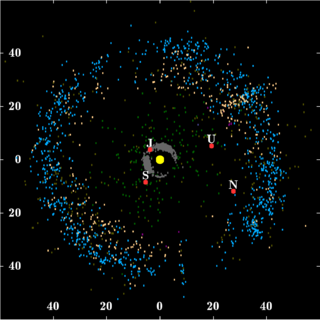
The Kuiper belt is a circumstellar disc in the outer Solar System, extending from the orbit of Neptune at 30 astronomical units (AU) to approximately 50 AU from the Sun. It is similar to the asteroid belt, but is far larger—20 times as wide and 20–200 times as massive. Like the asteroid belt, it consists mainly of small bodies or remnants from when the Solar System formed. While many asteroids are composed primarily of rock and metal, most Kuiper belt objects are composed largely of frozen volatiles, such as methane, ammonia, and water. The Kuiper belt is home to most of the objects that astronomers generally accept as dwarf planets: Orcus, Pluto, Haumea, Quaoar, and Makemake. Some of the Solar System's moons, such as Neptune's Triton and Saturn's Phoebe, may have originated in the region.

A pulley is a wheel on an axle or shaft enabling a taut cable or belt passing over the wheel to move and change direction, or transfer power between itself and a shaft. A sheave or pulley wheel is a pulley using an axle supported by a frame or shell (block) to guide a cable or exert force.

The Solar System is the gravitationally bound system of the Sun and the objects that orbit it. The largest of these objects are the eight planets, which in order from the Sun are four terrestrial planets ; two gas giants ; and two ice giants. The Solar System developed 4.6 billion years ago when a dense region of a molecular cloud collapsed, forming the Sun and a protoplanetary disc.
A trans-Neptunian object (TNO), also written transneptunian object, is any minor planet in the Solar System that orbits the Sun at a greater average distance than Neptune, which has an orbital semi-major axis of 30.1 astronomical units (au).

The asteroid belt is a torus-shaped region in the Solar System, centered on the Sun and roughly spanning the space between the orbits of the planets Jupiter and Mars. It contains a great many solid, irregularly shaped bodies called asteroids or minor planets. The identified objects are of many sizes, but much smaller than planets, and, on average, are about one million kilometers apart. This asteroid belt is also called the main asteroid belt or main belt to distinguish it from other asteroid populations in the Solar System.

A seat belt, also known as a safety belt or spelled seatbelt, is a vehicle safety device designed to secure the driver or a passenger of a vehicle against harmful movement that may result during a collision or a sudden stop. A seat belt reduces the likelihood of death or serious injury in a traffic collision by reducing the force of secondary impacts with interior strike hazards, by keeping occupants positioned correctly for maximum effectiveness of the airbag, and by preventing occupants being ejected from the vehicle in a crash or if the vehicle rolls over.
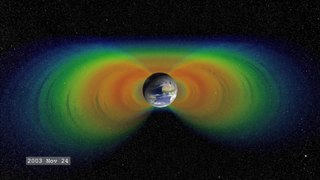
Van Allen radiation belt is a zone of energetic charged particles, most of which originate from the solar wind, that are captured by and held around a planet by that planet's magnetosphere. Earth has two such belts, and sometimes others may be temporarily created. The belts are named after James Van Allen, who is credited with their discovery.
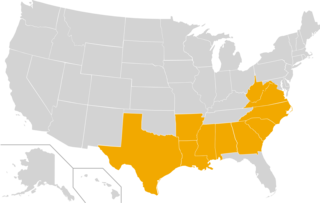
The Sun Belt Conference (SBC) is a collegiate athletic conference that has been affiliated with the NCAA's Division I since 1976. Originally a non-football conference, the Sun Belt began sponsoring football in 2001. Its football teams participate in the Division I Football Bowl Subdivision (FBS). The 14 member institutions of the Sun Belt are distributed across the Southern United States.
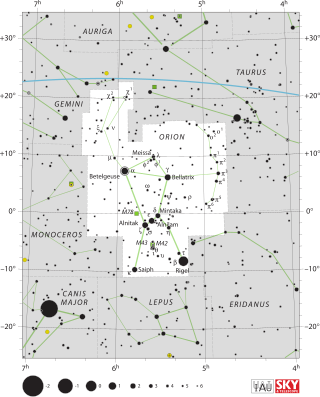
Orion is a prominent set of stars visible during winter in the northern celestial hemisphere. It is one of the 88 modern constellations; it was among the 48 constellations listed by the 2nd-century astronomer Ptolemy. It is named for a hunter in Greek mythology.
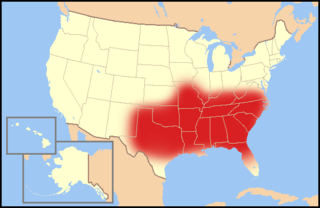
The Bible Belt is a region of the Southern United States and one Midwestern state, the state of Missouri, in all of which socially conservative Protestant Christianity plays a strong role in society. Church attendance across the denominations is generally higher than the nation's average. The region contrasts with the religiously diverse Midwest and Great Lakes, and the Mormon corridor in Utah,southern Idaho and northern Arizona.
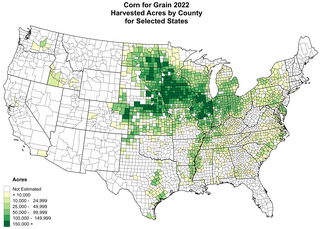
The Corn Belt is a region of the Midwestern United States and part of the Southern United States that, since the 1850s, has dominated corn production in the United States. In North America, corn is the common word for maize. More generally, the concept of the Corn Belt connotes the area of the Midwest dominated by farming and agriculture.

In East Asian martial arts, the black belt is associated with expertise, but may indicate only competence, depending on the martial art. The use of colored belts is a relatively recent invention dating from the 1880s.

The NWA Worlds Heavyweight Championship is a men's professional wrestling world heavyweight championship owned and promoted by the National Wrestling Alliance (NWA), an American professional wrestling promotion. The current champion is EC3, who is in his first reign.

A continuously variable transmission (CVT) is an automated transmission that can change through a continuous range of gear ratios. This contrasts with other transmissions that provide a limited number of gear ratios in fixed steps. The flexibility of a CVT with suitable control may allow the engine to operate at a constant angular velocity while the vehicle moves at varying speeds.

The WWE Championship is a men's professional wrestling world heavyweight championship created and promoted by the American promotion WWE, defended on the SmackDown brand division. Since April 2022, the title has been jointly held and defended with the WWE Universal Championship as the Undisputed WWE Universal Championship, but both titles have maintained their individual lineages. It is one of three world titles in WWE, alongside its companion Universal Championship on SmackDown, and the World Heavyweight Championship on Raw. The current champion is Roman Reigns, who is in his fourth reign. He won the title by defeating Brock Lesnar in a Winner Takes All match at WrestleMania 38 Night 2 on April 3, 2022, subsequently becoming the Undisputed WWE Universal Champion.
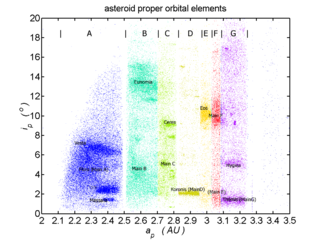
An asteroid family is a population of asteroids that share similar proper orbital elements, such as semimajor axis, eccentricity, and orbital inclination. The members of the families are thought to be fragments of past asteroid collisions. An asteroid family is a more specific term than asteroid group whose members, while sharing some broad orbital characteristics, may be otherwise unrelated to each other.

A belt is a loop of flexible material used to link two or more rotating shafts mechanically, most often parallel. Belts may be used as a source of motion, to transmit power efficiently or to track relative movement. Belts are looped over pulleys and may have a twist between the pulleys, and the shafts need not be parallel.
Planet V is a hypothetical fifth terrestrial planet posited by NASA scientists John Chambers and Jack J. Lissauer to have once existed between Mars and the asteroid belt. In their hypothesis the Late Heavy Bombardment of the Hadean era began after perturbations from the other terrestrial planets caused Planet V's orbit to cross into the asteroid belt. Chambers and Lissauer presented the results of initial tests of this hypothesis during the 33rd Lunar and Planetary Science Conference, held from March 11 through 15, 2002.

The scattered disc (or scattered disk) is a distant circumstellar disc in the Solar System that is sparsely populated by icy small Solar System bodies, which are a subset of the broader family of trans-Neptunian objects. The scattered-disc objects (SDOs) have orbital eccentricities ranging as high as 0.8, inclinations as high as 40°, and perihelia greater than 30 astronomical units (4.5×109 km; 2.8×109 mi). These extreme orbits are thought to be the result of gravitational "scattering" by the gas giants, and the objects continue to be subject to perturbation by the planet Neptune.

The Belt and Road Initiative, known within China as the One Belt One Road or OBOR/1B1R for short, sometimes referred to as the New Silk Road, is a global infrastructure development strategy adopted by the Chinese government in 2013 to invest in more than 150 countries and international organizations. It is considered a centerpiece of the Chinese leader Xi Jinping's foreign policy. The BRI forms a central component of Xi's "Major Country Diplomacy" strategy, which calls for China to assume a greater leadership role for global affairs in accordance with its rising power and status. It has been compared to the American Marshall Plan. As of August 2023, 155 countries were listed as having signed up to the BRI. The participating countries include almost 75% of the world's population and account for more than half of the world's GDP.
References
- ↑ Georgano, N. (2000). Beaulieu Encyclopedia of the Automobile. London: HMSO. ISBN 1-57958-293-1.[ page needed ]